Isabella Bradford's Blog, page 45
November 7, 2016
Election Day
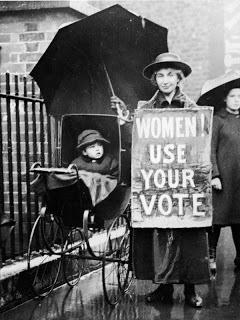 Isabella reporting,
Isabella reporting,No matter who wins the United States election today, there will be so much history being made that a history-related blog post today seems sort of unnecessary. It's history that all we Americans have a chance to help create, too. This early 20thc woman has the right idea, and Loretta and I completely agree with her (though we hope all you men go to the polls as well.) Use your vote!
"Women! Use Your Vote", early 20thc, Getty Images.
Published on November 07, 2016 21:00
November 6, 2016
From the Archives: Creating Fashionable Coiffures in 1828
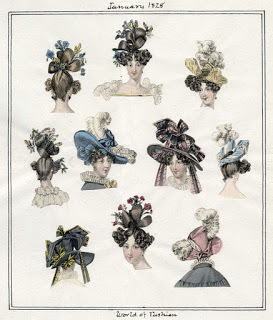 1828 hair styles & headwear
Loretta reports:
1828 hair styles & headwear
Loretta reports:In my book Lord of Scoundrels , set in 1828, the hero finds the heroine's clothing and hair amusing. I know that when our readers see the fashion plates for the 1820s and 1830s, many feel the same way. But I love Romantic Era fashion, especially the extravagant sleeves and nutty hairstyles. There's an exuberance I find irresistible. The hair, especially, climbing ever upwards, charms me. But one does wonder how this sort of architectural arrangement was managed in the days before hair spray and gels.
Isabella/Susan to the rescue! She sent me a link to a site where historical hairstyles are recreated . This inspired me to investigate how it was done and what hair products they used. So I turned to my trusty The Lady’s Stratagem .
One style we see again and again involves two or more big loops sprouting from the top of the head. In fashion plates, these present an interesting hairstyling puzzle, which the recreations (Photo 2, top row. Photos 1 & 2, second row) help solve. According to The Lady’s Stratagem, the hair can be tied first or:
“Just as commonly, the hair is not tied: you gather it and hold it very firmly In your left hand, twist it with this same hand, and immediately place the comb on it to hold it. Then you make nœuds d’Apollon or Apollo knots; so are called the large loops of hair on the summit of the head. This style has been in fashion for a long time; every one says that it will last.”And it did, well into the 1830s, until about 1836-7, when fashion went droopy.
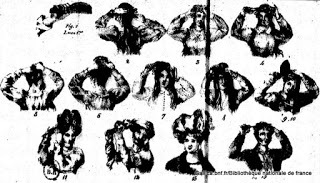 1828 hair dressing
1828 hair dressing
Since the instructions quoted in The Lady’s Stratagem are lengthy, I can only refer you to that book for the details on creating this style—or, if your French is better than mine, you can follow the directions in Arte de se coiffer soi-même, enseigné aux dames (1828) ( here or here ).
From what I can determine, one of the hair oils we’ve seen advertised or similar product or a pomade was used to keep hair smoothly in place.
Images: upper left, courtesy Los Angeles Public Library; lower right from Arte de se coiffer soi-même, enseigné aux dames, courtesy Bibliothèque nationale de france.
Clicking on the image will enlarge it. Clicking on the caption will take you to the source, where you enlarge further and find out more.
Published on November 06, 2016 21:30
November 5, 2016
Breakfast Links: Week of October 31, 2016
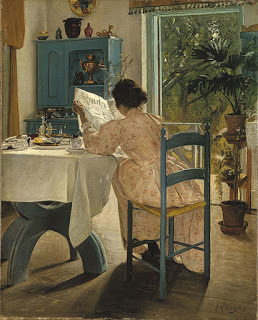 Breakfast Links are served - our weekly round-up of fav links to other web sites, articles, blogs, and images via Twitter.
Breakfast Links are served - our weekly round-up of fav links to other web sites, articles, blogs, and images via Twitter.• A dress of Spitalfields silk.
• A place that harbors memory: the children's burial grounds in Mayo.
• Sure to ease voting concerns: 18thc recipe for Election Cake .
• Where did those pointy, black, "witch hats" come from?
• The divine messages of a Victorian spiritualist's drawings.
• The Scottish play and the real Macbeth .
• Monkeys acting like humans in art.
• A woman's work: the market Narrative of Nancy Prince .
• Floating worlds: the letters (and envelopes) of Edward Gorey .
• Adelaide Knight , leader of the first east London suffragettes.
• Image: World War Two soldiers made clear grips for their pistols to display photos of their sweethearts.
• The problem with museum acquisitions ....
• Long-toppled statue of King George III to ride again, thanks to a Brooklyn studio.
• Thomas Edison's least successful invention was the Spirit Phone .
• Image: Never be lost: 17thc map-patterned court robes
• Mid-life crisis? John Adams contemplates his birthday.
• The mysterious and majestic stone circle at Lochbuie, on the Isle of Mull.
• The Green Book was an essential guide for 20thc black motorists.
• Image: Victorian-era embroidered slippers .
• The Empress Josephine and the French prophetess.
• The strange history of books bound in human skin .
• Discovering a Belle Epoque theatre inside a Parisian shoe store.
• Nelly Custis, George Washington's step-granddaughter, received many letters from the Lafayette family; explore them here .
• How Britain learned about bathrooms from the Ottoman Empire.
• Image: A whimsical book store sign in the Netherlands.
• Are book collectors really readers, or just cultural snobs?
• The story of 20thc Stepney sewing machinist Marie Iles.
• For all of you watching Poldark : the history behind the series.
• Video: A real-life race between a tortoise and a hare . Guess which one wins?
Hungry for more? Follow us on Twitter @2nerdyhistgirls for fresh updates daily.
Above: At Breakfast by Laurits Andersen Ring. Private collection.
Published on November 05, 2016 14:00
November 3, 2016
Friday Video: Jewelry & Its Stories at the V&A
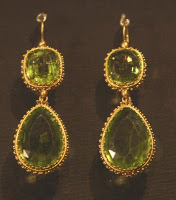 Loretta reports:
Loretta reports:A while back, Susan/Isabella posted a blog about a jewelry reward the Prince Regent gave to the women he’d entrusted with keeping his daughter, the Princess Charlotte, from running amok.
Today’s video spotlights these peridots as well as revealing the letter’s contents—and can’t you just picture the conditions under which the letter was written? In a few cryptic words, the writer conjures quite a scene—at least in this writer’s mind.
This isn’t the V&A jewelry collection's only story. The video features several other pieces, including some worn by Catherine the Great. I was particularly intrigued by the tale of how one modern piece was created.
Readers who receive our blog via email might see a rectangle, square, or nothing where the video ought to be. To watch the video, please click on the title to this post.
Published on November 03, 2016 21:30
November 2, 2016
From the Archives: How Guy Fawkes Crossed the Atlantic & Became Pope Night, 1745
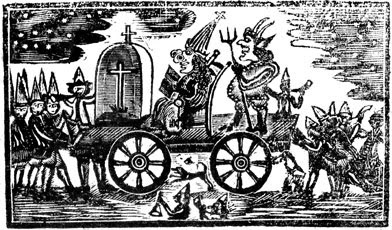
Isabella reporting:
Because our friends in Great Britain will celebrate Guy Fawkes Day on Saturday, it seems like an excellent time to revisit this post.
Guy Fawkes Day is a holiday that may have a dark past, but it's certainly alive and well and full of bonfires and fireworks. Yet while it may seem a quintessentially British holiday, there's also a strong history of the celebration in New England as well as Old.
The Massachusetts colony was largely settled in the early 17th c. by English Puritans, and those conservative Protestant values continued to rule the colony. The bonfires and effigy-burning of the Fifth of November was one of the transplanted traditions that prospered, but by the middle of the 18th c., it had developed a few distinctly Yankee quirks. Several colonial wars against the French served to increase distrust and fear of Catholics. While the memory of Guy Fawkes and the Gunpowder Plot weren't forgotten (the "Remember, Remember" song was duly sung), in all the northern colonies the celebration was now called Pope Night, and a rowdy time it was.
In Boston, crowds of young men, sailors, and apprentices thronged the streets, dividing into two rival gangs, while costumed boys thumped on doors and begged money for drink. Each gang had their own procession and effigies of the Pope, friars, priests, and devils, and after a fierce brawl between the two gangs (ah, American contests of sports supremacy!), the winners captured the losers' effigies, and everything was finally burned in a satisfying bonfire. Special noisemakers, fashioned from conch shells and called "Pope's horns", added to the din, like 18th c. vuvuzelas.
As political tensions in Boston increased with England in the years before the Revolution, other effigies of unpopular public figures found their way into the procession, including the Catholic Pretender to the British throne James Stuart, Lord North, and Lord Bute. Later infamous Revolutionary War traitor Benedict Arnold earned his place in the flames, too. A 1745 newspaper described the scene:
Tuesday last being the Anniversary of the Gunpowder Plot, two Popes were made and carried thro' the Streets in the evening...attended by a vast number...armed with clubs, staves, and cutlashes, who were very abusive to the Inhabitants, insulting the Persons and breaking the windows, &c., of such as did not give them money to their satisfaction...the two Popes meeting in Cornhill, their followers were so infatuated as to fall upon each other with the utmost Rage and Fury. Several were sorely wounded and bruised, some left for dead, and rendered incapable of any business for a long time to the great Loss and Damage of their respective Masters.
For more about Pope Night in the American colonies, check out this excellent site commissioned by The Bostonian Society. Also see one of our favorite history blogs, Boston 1775 , which has numerous posts on the subject.
Above: Detail from Extraordinary verses on Pope-night, or, A commemoration of the Fifth of November, giving a history of the attempt, made by the papishes, to blow up king and Parliament, printed in Boston, 1768. Collection, Library of Congress
Published on November 02, 2016 21:00
From the Archives: Guy Fawkes Crosses the Atlantic & Becomes Pope Night, 1745

Isabella reporting:
Because our friends in Great Britain will celebrate Guy Fawkes Day on Saturday, it seems like an excellent time to revisit this post.
Guy Fawkes Day is a holiday that may have a dark past, but it's certainly alive and well and full of bonfires and fireworks. Yet while it may seem a quintessentially British holiday, there's also a strong history of the celebration in New England as well as Old.
The Massachusetts colony was largely settled in the early 17th c. by English Puritans, and those conservative Protestant values continued to rule the colony. The bonfires and effigy-burning of the Fifth of November was one of the transplanted traditions that prospered, but by the middle of the 18th c., it had developed a few distinctly Yankee quirks. Several colonial wars against the French served to increase distrust and fear of Catholics. While the memory of Guy Fawkes and the Gunpowder Plot weren't forgotten (the "Remember, Remember" song was duly sung), in all the northern colonies the celebration was now called Pope Night, and a rowdy time it was.
In Boston, crowds of young men, sailors, and apprentices thronged the streets, dividing into two rival gangs, while costumed boys thumped on doors and begged money for drink. Each gang had their own procession and effigies of the Pope, friars, priests, and devils, and after a fierce brawl between the two gangs (ah, American contests of sports supremacy!), the winners captured the losers' effigies, and everything was finally burned in a satisfying bonfire. Special noisemakers, fashioned from conch shells and called "Pope's horns", added to the din, like 18th c. vuvuzelas.
As political tensions in Boston increased with England in the years before the Revolution, other effigies of unpopular public figures found their way into the procession, including the Catholic Pretender to the British throne James Stuart, Lord North, and Lord Bute. Later infamous Revolutionary War traitor Benedict Arnold earned his place in the flames, too. A 1745 newspaper described the scene:
Tuesday last being the Anniversary of the Gunpowder Plot, two Popes were made and carried thro' the Streets in the evening...attended by a vast number...armed with clubs, staves, and cutlashes, who were very abusive to the Inhabitants, insulting the Persons and breaking the windows, &c., of such as did not give them money to their satisfaction...the two Popes meeting in Cornhill, their followers were so infatuated as to fall upon each other with the utmost Rage and Fury. Several were sorely wounded and bruised, some left for dead, and rendered incapable of any business for a long time to the great Loss and Damage of their respective Masters.
For more about Pope Night in the American colonies, check out this excellent site commissioned by The Bostonian Society. Also see one of our favorite history blogs, Boston 1775 , which has numerous posts on the subject.
Above: Detail from Extraordinary verses on Pope-night, or, A commemoration of the Fifth of November, giving a history of the attempt, made by the papishes, to blow up king and Parliament, printed in Boston, 1768. Collection, Library of Congress
Published on November 02, 2016 21:00
October 31, 2016
Fashions for November 1908
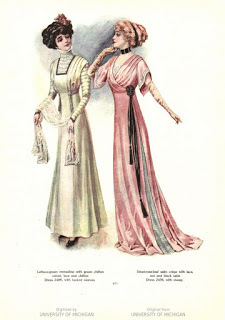 Dresses November 1908
Loretta reports:
Dresses November 1908
Loretta reports:Between 1907 and 1908 fashion underwent a major change in terms of silhouette. If you compare this plate to the one posted at left, the difference is obvious. The top-heavy S-curve has smoothed out, and a more vertical look—which may remind you a bit of the Regency style—has taken over.
According to Jane Ashelford’s The Art of Dress ,
“the waistband was raised above its natural level, the skirt was narrowed, and the longer and straighter-fitting corset, introduced in 1908, produced a much smoother and more elongated shape.”
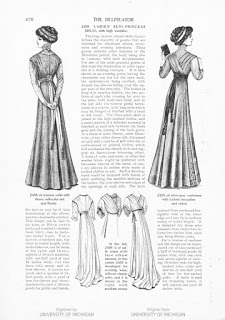 November 1908 dress descriptions
November 1908 dress descriptions
Images courtesy University of Michigan via Hathi Trust.
Clicking on the image will enlarge it. Clicking on the caption will take you to the source, where you can learn more and enlarge images as needed.
Published on October 31, 2016 21:30
October 30, 2016
Finding Relief in the Lady's Garden at Vauxhall, 1788
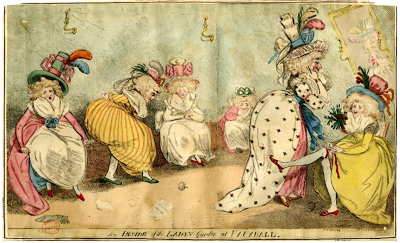
Isabella reporting,
As interesting as all life in the past is to us now, it's the common aspects that our readers seem to find most interesting. Forget riding in a coach or dancing in hoops. Where and how did our heroines answer nature's call before indoor plumbing? This explains why a six-year-old blog post on the necessary bourdaloue remains one of our all-time most popular - and why this 18thc satirical print will probably be both amusing and informative. As always, please click on the image to enlarge it.
The pleasure gardens at Vauxhall were among the most popular entertainment spots in Georgian London. Several generations of Londoners of every rank put on their finery (and the occasional mask) and came to stroll, dance, dine, and flirt beneath the legendary lights. With its tree-shaded paths, Chinese-inspired pavilions, popular music, and statues and paintings by famous artists, there was much to amuse - and plenty of places to find mischief, too.
But even Vauxhall's glamorous settings had a baser side. It had to, after all that drinking and dining. Or as Christopher Smart observed in a popular journal:
"In sweet Vaux-hall I love to stray:
But wish it were completely gay:
In splendid Scenes we drink and eat:
In sordid Huts – evacuate."*
Apparently many visitors of both sexes didn't bother to seek out the "sordid Huts", but chose to take advantage of the shadowy paths and bushes to relieve themselves. For ladies who were a fraction more fastidious, there was also the "Lady's Garden", shown in this 1788 print.
Apparently being reserved for the use of ladies didn't mean the facilities had much in the way of amenities or privacy. Along two walls is a bench forming a communal latrine, with four women in various stages of relief and distress, their fashionable skirts gathered up around them. Keep in mind that there would have been no "flushing" mechanism beneath the women, and imagine what the smell must have been by the end of a busy evening.
The towering plumes on the women's hats and in their powdered hairstyles come dangerously close to the open flames of the candles in wall sconces behind them, offering one more hazard. Discarded on the floor are a nosegay, an unmatched glove, and an advertisement sheet - which probably would have been used in place of modern toilet paper - for Dr. Leak's pills, a popular quack venereal remedy and a sly jab at the sexual assignations that often occurred at Vauxhall.
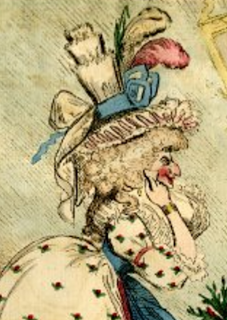
To the right sits one woman ostentatiously retying her garter, perhaps a potential customer for Dr. Leake, while another is freshening her makeup at a looking glass. This tall woman, detail right, is believed to be Lady Sarah Archer, an aristocratic widow famous for her independence, her love of gambling, and her interest in politics and outdoor sports (she drove her own phaeton and rode to the hounds.) In the eyes of misogynistic 18thc caricaturists, however, her greatest sin was being over forty with a fondness for makeup and fashion. She is always cruelly drawn with florid cheeks and an exaggerated hooked nose to accentuate her supposedly unfeminine appearance - and what better way to mock her further than to show her painting her face in a communal outhouse?
* From the wonderful Vauxhall Gardens: A History by David Coke & Alan Borg. See Loretta's post about this book here.
Above: The inside of the lady's garden at Vauxhall Drawing attributed to Henry Kingsbury; published S.W. Fores, 1788. The British Museum.
Published on October 30, 2016 17:00
October 29, 2016
Breakfast Links: Week of October 24, 2016
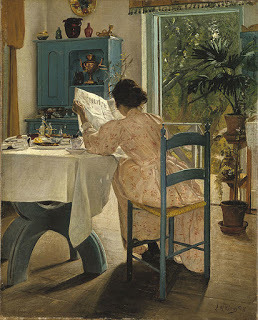 Breakfast Links are served - our weekly round-up of fav links to other web sites, articles, blogs, and images via Twitter.
Breakfast Links are served - our weekly round-up of fav links to other web sites, articles, blogs, and images via Twitter.• The ghosts of Old London.
• After World War One: A silk surplus , armistice fashion, and a philanthropic innovator.
• How four young brothers skipped out on digging potatoes and walked sixteen miles to watch the British army march to Cambridge in 1775.
• An 1837 court case over how a woman fought back after an unwanted kiss .
• Bringing the drugstore home: the history of the bathroom medicine cabinet .
• Image: Dr. Townsend's residence was the largest in New York City when it was built in 1853; it only survived until 1868, when it was torn down to build another, larger house.
• Cured by a nightmare .
• How ancient Roman athletes and fans cursed rival teams during the postseason.
• Dr. James Barry : the woman who fooled the Royal College of Surgeons, Queen Victoria, and the world.
• Country house telephones .
• Chasing the sun: Annie Maunder , the 19thc woman forgotten by science.
• Image: Victorian slippers embroidered with floral motifs.
• The halls of the Great Exhibition , 1851.
• Central Park's lost statue to Commerce .
• What do people most get wrong about history ?
• Jet and dressed in black in the Victorian era.
• Period pains : how were women's menstrual cramps regarded in the past?
• Image: Rare early color photograph of young Russian peasant women , 1909.
• Stepping back in time at a Parisian fencing club .
• Classical splendor: Painted furniture for a grand Philadelphia house in the early 19thc.
• The early 20thc fashion empire of Lucile - with roots in Guelph, Ontario.
• Which sister made this extravagant, mid-19thc pieced quilt ?
• When the world truly stank, tussie-mussies were a breath of fresh air.
• Image: Just for fun: discover your Regency name .
Hungry for more? Follow us on Twitter @2nerdyhistgirls for fresh updates daily.
Above: At Breakfast by Laurits Andersen Ring. Private collection.
Published on October 29, 2016 14:00
October 27, 2016
Friday Video(s): Fashion Treasures from the Museum of London
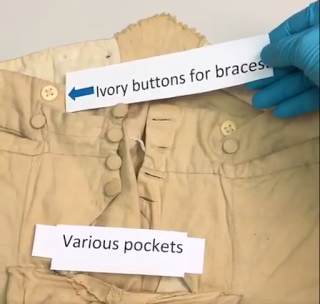 Isabella reporting:
Isabella reporting:Today's post combines the best of Friday Videos and Breakfast Links. Timothy Long, Curator of Fashion and Decorative Arts at the Museum of London, creates wonderful super-short videos highlighting special items from the collection. Most of the videos are largely silent with hand-lettered captioning as guideposts, and only Mr. Long's hands appear (clad in bright blue gloves) as he turns the garments.
So far, however, Mr. Long has yet to post the videos on YouTube or Vimeo, and so I can't embed them here. But this is too much under-a-minute information not to share, so here are links to some of my recent favorites. If you're on Twitter, you can also follow Mr. Long directly @fashion_curator . You never know what he'll uncover next!
• The finer details of a pair of super-skinny men's trousers , c1810, above, including a close look at how the seams split and were mended.
• The curious pocket on a 1940s blouse .
• Epaulettes c1900 in their own velvet-lined carrying case.
• Exploring the interior of a c1805 silk satin dress .
• The Countess of Airlie's ermine-trimmed velvet dress, below, was worn to the coronation in 1911 of George V, and again in 1937 for the coronation of George VI.
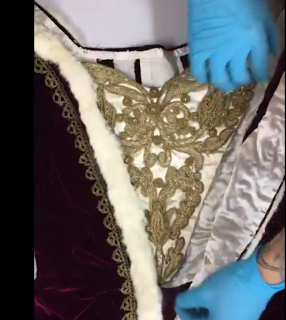
• An elaborate 1830s uniform coat that belonged to a Deputy Lieutenant of the City of London.
• Uncovering the sheets of archival tissue paper to reveal a glimpse into London's haberdashers.
• An 18thc embroidered men's coat with a mysterious past.
• Finally, what Mr. Long calls his favorite discovery of 2016 (so far): a collection of Edwardian chokers .
Published on October 27, 2016 21:00



